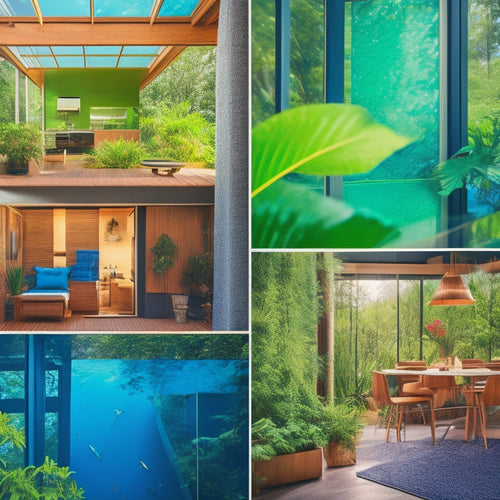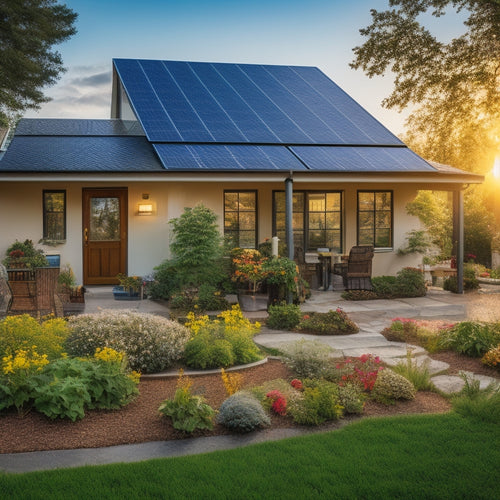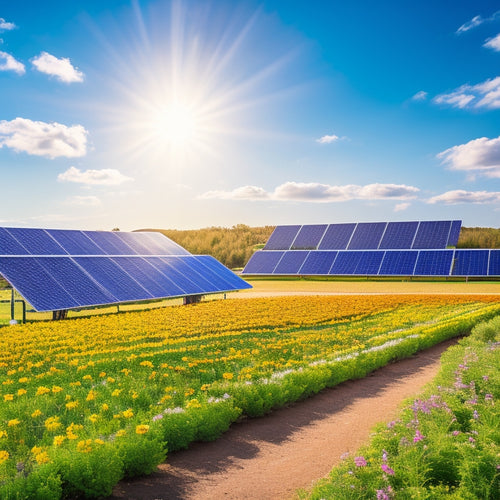Sustainable Storage: Solar Innovations for Home Organization
Share
By integrating solar power into your storage systems, you're not only reducing your reliance on non-renewable energy sources but also generating electricity to power your storage needs while minimizing your carbon footprint. This eco-friendly approach enables you to reduce energy bills and support a sustainable clutter control system. You can optimize energy usage and allocate resources to causes that matter. As you explore sustainable storage solutions, you'll discover more innovative ways to harness solar power and create a harmonious balance between physical and mental environments - and you're just getting started.
Key Takeaways
• Solar power integration in storage systems reduces carbon footprint and energy bills while providing a cost-effective solution.
• Reclaimed wood and bamboo shelves offer eco-friendly storage options, minimizing waste and supporting sustainable forestry practices.
• Maximizing vertical space and utilizing wall-mounted storage optimize storage capacity and maintain a sense of openness in compact living spaces.
• Advanced photovoltaic panels and optimized energy storage systems enable rapid charging and reduce reliance on fossil fuels.
• Smart home automation and integration enable hands-free control, real-time energy monitoring, and data-driven decisions to reduce carbon footprint.
Solar Power for Home Storage
As you consider sustainable storage solutions, harnessing solar power for home storage can substantially reduce your reliance on non-renewable energy sources.
By integrating solar panels into your storage system, you can generate electricity and store excess energy for later use. This not only reduces your carbon footprint but also provides a cost-effective solution for powering your storage needs.
With solar power, you can enjoy significant Solar Savings on your energy bills.
Eco-Friendly Shelving Solutions
As you explore eco-friendly shelving solutions, you'll want to weigh reclaimed wood options that reduce waste and support sustainable forestry practices.
You'll also benefit from space-saving designs that maximize storage capacity while minimizing the overall footprint.
Reclaimed Wood Options
You can opt for reclaimed wood shelves, which not only reduce waste but also add a touch of history and character to your storage space. By choosing reclaimed wood, you're giving new life to materials that would've otherwise ended up in landfills. This eco-friendly option is perfect for those who want to minimize their carbon footprint.
Reclaimed wood shelves often feature unique wood accents that add a rustic charm to your storage space. The weathered, distressed look of reclaimed wood gives your shelves a one-of-a-kind character that's hard to replicate with new materials. Plus, the natural imperfections of reclaimed wood add a touch of warmth and coziness to your space.
When selecting reclaimed wood shelves, look for sustainable sources that certify the wood is harvested responsibly. You can also consider upcycling old pallets, crates, or fencing to create your own unique shelving units. With reclaimed wood options, you can create a storage space that's not only eco-friendly but also visually stunning.
Space-Saving Designs
By incorporating space-saving designs into your storage space, you can maximize your shelving capacity while minimizing your environmental impact.
Eco-friendly shelving solutions that prioritize functionality and sustainability are essential in today's eco-conscious world.
One innovative approach is the use of foldable furniture, which allows you to easily assemble and disassemble shelves as needed. This not only reduces waste but also enables you to adapt your storage space to changing needs.
Modular layouts are another key aspect of space-saving designs. By using interchangeable components, you can create a customized shelving system that efficiently uses available space.
This approach also enables you to easily rearrange or expand your storage space as your needs evolve. By embracing space-saving designs, you can reduce your carbon footprint, optimize your storage capacity, and create a more sustainable living space.
Renewable Energy for Clutter Control
Harnessing renewable energy sources, such as solar or wind power, can substantially reduce the carbon footprint of your storage facilities, ultimately contributing to a more sustainable clutter control system.
By integrating energy-efficient systems, you'll not only minimize your environmental impact but also reduce your energy costs. This, in turn, allows you to allocate more resources to supporting causes that matter to you.
In the context of clutter psychology, a well-organized space can have a profound impact on your mental well-being.
By incorporating renewable energy into your storage solutions, you'll be creating a harmonious balance between your physical and mental environments. Energy efficiency is key to achieving this balance.
By optimizing your energy usage, you'll be able to dedicate more time and resources to serving others, whether that's through volunteering, donating, or simply being present for those around you.
As you undertake your sustainable storage journey, remember that every small step towards energy efficiency counts, and the positive ripple effects will be felt far beyond your own clutter control system.
Sustainable Closet Organization Systems
As you design your sustainable closet organization system, you'll want to ponder eco-friendly shelving options that reduce waste and minimize environmental impact.
You'll also need to optimize your closet's spatial layout to maximize storage capacity, which is where space-saving designs come into play.
Eco-Friendly Shelving Options
You can create a more sustainable closet space by opting for eco-friendly shelving options that not only reduce your environmental footprint but also enhance the overall aesthetic of your storage area.
Bamboo shelving is an excellent choice, offering numerous benefits such as being highly renewable, durable, and resistant to pests and decay. Additionally, bamboo has natural antimicrobial properties, reducing the growth of mold and mildew.
Another eco-friendly option is using recycled materials for your shelving. Repurposed wood, reclaimed from old buildings or salvaged from sustainable forests, reduces waste and conserves natural resources.
You can also opt for shelving made from recycled metal or plastic, decreasing the amount of waste sent to landfills.
Space-Saving Closet Designs
By incorporating double rods, shelves, and bins, your closet can be optimized to hold more items in a smaller footprint, creating a clutter-free and functional space that makes the most of available square footage.
This is especially important in smaller homes or apartments where every inch counts. A well-designed closet organization system can increase your storage capacity, making it easier to find what you need and reducing stress in the process.
To achieve a closet revamp, consider implementing storage hacks such as using stackable bins, hanging organizers, and shelves with built-in drawers.
These clever solutions will help you maximize your closet's vertical space, keeping your belongings organized and out of sight. By doing so, you'll create a peaceful and serene environment that promotes a sense of calm and relaxation.
With a little creativity and some smart design choices, you can transform your closet into a tranquil oasis that makes your daily routine more efficient and enjoyable.
Harnessing Natural Light for Storage
Natural light pours in through clerestory windows, skylights, or transparent roofing materials, substantially reducing the need for artificial lighting in storage facilities.
By harnessing natural light, you can create a sustainable storage space that not only saves energy but also promotes a sense of well-being. A well-designed storage area with ample natural light can create a natural ambiance, making it more inviting and comfortable to spend time in.
You can optimize natural light by placing sunlit shelves near windows or skylights, allowing you to store items in a bright and airy environment.
This not only reduces the need for artificial lighting but also helps to prevent moisture buildup, which can lead to mold and mildew. By incorporating natural light into your storage design, you can create a space that's both functional and sustainable.
Additionally, natural light can help to highlight any imperfections in your storage space, encouraging you to maintain a tidy and organized environment.
Green Storage for Small Spaces
As you design your green storage for small spaces, you'll want to prioritize maximizing your vertical space to make the most of every inch.
Next, consider the eco-friendly shelf materials that will help reduce your storage's carbon footprint.
Maximizing Vertical Space
Your compact living space can greatly benefit from maximizing vertical space, allowing you to store more while maintaining a clutter-free environment. By utilizing your ceiling and vertical boundaries, you can create a more organized and efficient living area.
To maximize vertical space, consider the following strategies:
| Technique | Description |
|---|---|
| Install floor-to-ceiling shelves | Use the entire vertical space to store items like books, decorations, or linens. |
| Utilize wall-mounted storage | Hang items like bikes, tools, or accessories to free up floor space. |
| Invest in stackable containers | Use bins and baskets to store items like clothing, toys, or kitchen utensils. |
| Opt for vertical file organizers | Keep important documents and papers organized and within reach. |
| Incorporate ceiling-mounted storage | Hang items like pots, pans, or even a bike from the ceiling to maximize overhead space. |
Eco-Friendly Shelf Materials
When selecting materials for your vertically maximized storage solutions, you'll want to choose eco-friendly shelf materials that minimize environmental impact while maintaining durability and functionality.
Bamboo is an excellent option, offering numerous benefits. It's a highly renewable resource, with some species growing up to 3 feet per day! Bamboo shelves are also incredibly durable, resistant to scratches and cracks. In addition, bamboo requires minimal processing, reducing the carbon footprint of your storage solution.
Another eco-friendly material is recycled plastics. Reusing plastic waste reduces the amount of waste in landfills and conserves natural resources. Look for recycled plastic shelves made from post-consumer materials, such as recycled polyethylene terephthalate (rPET).
These shelves aren't only eco-friendly but also offer excellent durability and resistance to moisture. By choosing eco-friendly shelf materials like bamboo and recycled plastics, you'll be minimizing your environmental impact while creating a functional and sustainable storage space.
Compact Storage Designs
In small spaces, optimizing storage capacity is essential, so designers and homeowners alike are turning to compact storage designs that maximize vertical space, cleverly conceal clutter, and maintain a sense of openness.
You can achieve this by incorporating foldable furniture, which can be easily stowed away when not in use, freeing up valuable floor space.
Modular units are another innovative solution, allowing you to customize your storage needs by combining individual units to create a tailored storage system.
These units can be easily rearranged or added to as your storage needs change, making them an ideal solution for small spaces.
Efficient Solar Charging Stations
By integrating advanced photovoltaic panels and optimized energy storage systems, efficient solar charging stations can now fully recharge electric vehicles in under 30 minutes.
This rapid charging capability is made possible by the ability to harness and store excess energy generated by solar farms during the day.
As a result, you can now conveniently charge your electric vehicle at home, reducing your carbon footprint and reliance on fossil fuels.
These efficient solar charging stations serve as energy hubs, providing a reliable and sustainable source of power for your home and transportation needs.
By installing a solar charging station, you'll not only reduce your energy costs but also contribute to a cleaner, more sustainable environment.
With the ability to monitor and control energy usage remotely, you'll have complete visibility into your energy consumption and production.
Innovative Battery Storage Options
You can now choose from a range of innovative battery storage options, each designed to optimize energy efficiency and reduce your reliance on the grid.
These advanced batteries provide a reliable source of power, guaranteeing you have energy when you need it most.
With grid resiliency in mind, these storage solutions are designed to withstand power outages and fluctuations, keeping your home running smoothly.
By investing in energy autonomy, you'll reduce your dependence on the grid and lower your carbon footprint.
When selecting a battery storage option, consider the type of battery technology, capacity, and compatibility with your existing solar panel system.
Look for batteries with high depth of discharge (DOD) rates, which allow for maximum energy utilization.
Additionally, consider the warranty and maintenance requirements to guarantee your system operates efficiently over its lifespan.
Smart Home Automation Integration
Integrate your energy storage system with smart home automation to access seamless control and monitoring of your energy usage, allowing you to optimize your energy efficiency and minimize waste. With smart home automation integration, you can effortlessly monitor and manage your energy consumption, receive real-time updates, and make data-driven decisions to reduce your carbon footprint.
Here's a breakdown of how smart home automation integration can enhance your sustainable storage experience:
| Feature | Benefit | Example |
|---|---|---|
| Voice Commands | Hands-free control of your energy storage system | "Hey Alexa, what's my current energy usage?" |
| Smart Routines | Automated energy management based on your daily habits | "Goodnight" routine turns off unnecessary appliances |
| Energy Monitoring | Real-time tracking of your energy consumption | Receive notifications when energy usage exceeds a set threshold |
DIY Solar Storage Installation
With a few essential tools and some basic electrical knowledge, you can successfully install your own solar storage system, saving money on labor costs and gaining hands-on experience with your sustainable energy setup.
However, before you begin, obtain the necessary Solar Permits from your local authorities. This won't only guarantee compliance with regulations but also verify a safe and efficient installation.
Conducting an Energy Audit is also vital in determining your energy requirements and identifying areas of improvement. This will help you optimize your solar storage system's performance and maximize your energy savings.
When selecting your solar storage equipment, consider factors such as battery type, capacity, and compatibility with your existing solar panel system.
During installation, follow the manufacturer's instructions and take necessary safety precautions to avoid electrical shocks or fires. Verify that all connections are secure, and the system is properly grounded.
Off-Grid Storage Solutions Explained
Off-grid storage solutions empower homeowners to harvest and store renewable energy, providing autonomy from the grid and a reliable backup during power outages. As you consider adopting off-grid storage, you'll want to understand the benefits and applications of these systems.
| Feature | Off-Grid Solution | Benefit |
|---|---|---|
| Energy Autonomy | Store excess energy generated by solar panels or wind turbines | Reduce reliance on the grid and enjoy energy independence |
| Rural Viability | Ideal for remote or rural areas with limited grid access | Provide energy resilience and reliability in areas with limited infrastructure |
| Backup Power | Automatically switch to stored energy during outages | Maintain a continuous power supply during grid outages or natural disasters |
| Scalability | Modular systems allow for easy expansion or upgrade | Adapt to changing energy needs and accommodate growing energy demands |
The Future of Sustainable Storage
As the world shifts towards a more sustainable future, you'll play a pivotal role in shaping the next generation of energy storage solutions.
The future of sustainable storage is exciting, and you're at the forefront of this revolution. You'll be instrumental in developing innovative solutions that not only reduce carbon footprints but also promote eco-friendly living.
A few glimpses into the future of sustainable storage include:
Energy Harvesting
Imagine homes equipped with advanced energy-harvesting systems that convert ambient energy into usable power.
Urban Mining
Envision a future where recyclable materials are extracted from waste, reducing the need for virgin resources.
Modular Storage
Picture modular storage units that can be easily assembled, disassembled, and reused, minimizing waste and promoting sustainability.
Biodegradable Materials
Imagine storage solutions crafted from biodegradable materials that can easily decompose, reducing landfill waste.
As you set out on this journey, you'll be part of a community that's dedicated to creating a more sustainable tomorrow.
Frequently Asked Questions
Can I Install Solar Panels on My Existing Storage Shed?
You can install solar panels on your existing storage shed, but first, verify your roof is prepared by inspecting and repairing any damaged or rotten areas, then consider a shed renovation to optimize energy harvesting.
Are Eco-Friendly Storage Solutions More Expensive Than Traditional Options?
You'll find that eco-friendly storage solutions often come at a higher upfront cost, but they offer long-term savings and a reduced environmental impact, making them a valuable investment for your wallet and the planet.
How Do I Determine My Energy Requirements for Solar Storage?
To determine your energy requirements for solar storage, you'll need to conduct an energy audit and perform load calculations to assess your energy usage patterns, identifying areas of inefficiency and opportunities for optimization.
Can I Use Solar Power for Outdoor Storage Units and Garages?
You can harness solar power for outdoor storage units and garages, achieving energy independence with off-grid systems that store excess energy for later use, reducing reliance on the grid.
Are There Any Government Incentives for Sustainable Storage Solutions?
You can explore government incentives for sustainable storage solutions, such as tax credits and green grants, which can help offset the cost of implementing eco-friendly storage solutions, making them more accessible to you.
Related Posts
-

Innovative Sustainable Materials for Energy-Efficient Homes
Innovative sustainable materials enable you to create energy-efficient homes while promoting environmental responsibi...
-

How to Achieve Energy Independence at Home
To achieve energy independence at home, start by investing in renewable energy sources like solar panels, wind turbin...
-

High-Performance Solar Solutions for Sustainable Living
High-performance solar solutions are your gateway to sustainable living, maximizing energy efficiency while considera...


